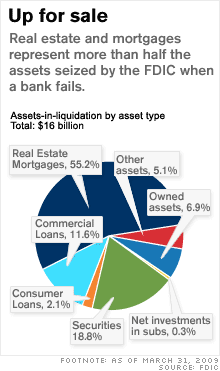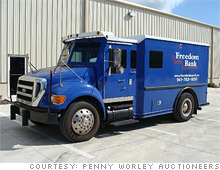Psst! Wanna own a bit of a failed bank?
With bank failures mounting, the FDIC is stuck trying to sell loans, real estate and more exotic assets like lawnmowers and even a Bentley.

 |
| Among the many non-traditional assets regulators seized when New Frontier Bank failed was this 2003 Bentley Arnage, which was sold for $50,000 at an auction held in May. |
 |
| Also put up for sale by the FDIC was this armored truck once owned by the Bradenton, Fla.-based lender Freedom Bank, which was shuttered last October. |
NEW YORK (CNNMoney.com) -- When New Frontier Bank failed in April, regulators failed to find a buyer, forcing the FDIC to absorb the roughly $2 billion in assets that were once owned by the Colorado-based lender.
But what the FDIC may not have anticipated at the time was that the agency would be stuck with a grab-bag of other exotic assets including a white Bentley Arnage, three lawnmowers, a Fleetwood Motor home and more than two dozen works of art, most of which reflected the bank's rural surroundings in northern Colorado.
The demise of New Frontier is just one example of the asset messes regulators are often stuck with once a bank is shuttered. At an auction held last month, regulators auctioned off a combined 300 copiers, printers and scanners that were once owned by the California mortgage lender IndyMac (IDMCQ), which collapsed last July in one of the biggest bank failures in history.
"It is just a potpourri of stuff," said Chip MacDonald, partner in the capital markets group at Jones Day, a law firm headquartered in Cleveland.
As of the end of March, the Federal Deposit Insurance Corp. had roughly $16 billion worth of failed bank assets just waiting to be liquidated, according to an agency report published earlier this month.
But that number is poised to climb higher as more banks fail. Last Friday, regulators seized five institutions across the country, the largest one-day instance of failures in years. Experts widely believe that that hundreds more banks could fail in the years ahead as a result of the current recession, which means plenty of work for the FDIC.
When a bank fails, the FDIC typically tries to find a buyer for the deposits and branches first before. If it's unsuccessful, as was the case with New Frontier, the FDIC then looks to sell off the bank's remaining assets.
Some of that work is handled by the agency itself, but much of it is farmed out to private-firms that specialize in managing and selling assets.
Regulators have largely looked to two firms - First Financial Network and DebtX - to market existing bank loans. Next month, Boston-based DebtX will oversee an auction for nearly $67 million in non-performing agriculture, consumer and business loans that were once owned by Illinois lender Corn Belt Bank and Trust Company, which failed in February.
The agency also recently struck agreements with a trio of auctioneer firms to handle the sale of everyday items used by the bank, such as computers, desks and other office furnishings, as well as cars, boats and industrial equipment a bank might have seized from borrowers that defaulted on their loans.
Helping to manage and sell both commercial and real estate properties for the FDIC is the Florida-based asset manager Prescient and commercial real estate giant CB Richard Ellis Group (CBG, Fortune 500) .
While regulators can shut down and sell an ailing bank to a healthier institution over the course of a weekend, winding down an orphan bank can take a bit longer.
For example, regulators have had to cautiously dismantle the Atlanta-based Silverton Bank after creating a bridge bank to take over the company in early May.
Given the firm's role as a so-called "bankers' bank" providing everyday services to small-town lenders, it could take a total of five months to wind down the institution, MacDonald said, referring to the situation as "a mess."
Timing, however, can be everything when a bank fails, especially as regulators scramble to squeeze every dime out of a failed bank's remaining assets.
Consider the case of Downey Financial (DWNFQ). Last fall, just two months before regulators seized the California-based lender, the company was shopping its twin-towered, six-story headquarters in Newport Beach for a reported $115 million.
The nearly 43,000-square-foot piece of property is still up for grabs, albeit at a deep discount. Prescient is currently asking for $59 million for the property, according to its Web site.
Bliss Morris, president and CEO of First Financial Network, a 20-year-old Oklahoma-City-based firm, said the same holds true in trying to sell loans on behalf of the FDIC -- the longer it takes to make a sale, the more likely it is that the loans will lose even more of their value.
Hoping to avoid some of those headaches, regulators have tried to forge loss-sharing arrangements with acquiring banks. Under such an arrangement, buyers agree to take on some of the bad assets in exchange for having the FDIC absorb some losses -- typically over the next five to 10 years.
Regulators brokered such a deal with a consortium of private equity firms in May before authorities shuttered the Florida lender BankUnited FSB.
"The agency works very hard to sell as many assets they can with the deposit franchise," said Robert Hartheimer, a Washington, D.C.-based consultant and adviser to Promontory Financial Group, who once served as director of the FDIC division charged with overseeing bank failures.
Even as such moves may soften the blow to the FDIC's deposit insurance fund, it is clear that the agency needs to get the maximum possible value it can from failed bank assets.
In the first quarter, the value of the deposit insurance fund fell by $4.3 billion, or nearly a quarter of its value, to just over $13 billion.
Luckily, the demand for failed bank assets have been robust by all accounts.
Auctions of the more mundane items like office furniture have attracted everyone from fellow bankers to a school administrator in Atlanta who was looking to add new desks for her growing student population.
"Everything we have attempted to sell has been sold," said Rick Levin, president of the Chicago-based firm Rick Levin & Associates, one of the auction firms assisting the FDIC with its asset sales. "We are finding strong demand."
And while the bidding for real estate and loans sales has been dominated by institutional investors so far, there are indications that average Joes are also starting to express interest in scooping up toxic assets.
Bill Bartmann, a former distressed bank debt investor who recently published a book entitled "Bailout Riches" aimed at teaching people how to profit from buying bad loans on the cheap, notes several of his students have invested as little as $5,000 in loans once owned by failed banks.
While such investments come with plenty of risk, it stands to reason that individual investors could generate similar returns to "vulture investors" who are gambling millions of dollars on the possibility that there is still some value in those loans.
"It doesn't always take a Morgan Stanley or Goldman Sachs to come to the table," he said. "This really is an opportunity." ![]()


